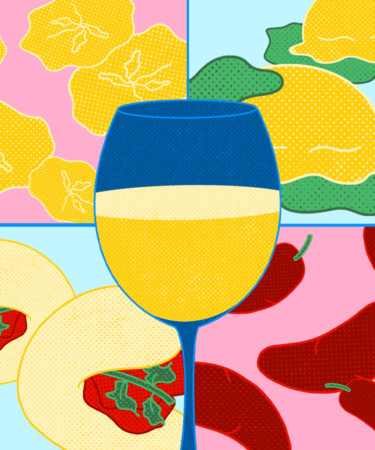A big part of wine tourism is the tasting room experience. Whether guests come for the views or for the liquid in their glasses, winery tasting rooms are an integral part of vineyard visits. These spaces, where guests are educated on the wines they’re tasting, act as a way for wineries to not only sell their products, but to also sell an experience.
And as tasting rooms often offer food, they can also be an added bonus for hungry patrons. But most tasting room menus are skewed toward a Eurocentric approach to food, with typical offerings of charcuterie and cheese accompanied by snacks such as olives, nuts, crackers, and honey. As the world comes out of the pandemic and tasting rooms reopen to wine lovers ready to explore, could this be the time to reexamine food menus and wine pairings in these spaces?
What if tasting rooms approached their menus from a truly international food perspective, branching from the norm while showcasing how wine can be a great complement to all cuisines? After all, there is more to wine and food pairings than meat and cheese — a fact some wineries are already beginning to embrace.
Overmountain Vineyards in western North Carolina is a family-owned and -operated winery, where food pairings are anything but expected. In the tasting room, father-daughter winemaking team Sofia and Frank Lilly highlight their Cuban roots. “Most people that visit the winery don’t really understand food and wine pairings,” says Ms. Lilly. “Once we partnered with Raul Taboada of Toasted Cuban Food Truck, we saw an opportunity to step outside the traditional wine pairing food box.”
The winery works with Taboada on pairing its wines with his recipes and additionally partners with various food trucks such as Seoul Republik, which serves up Korean-fusion fare, and Nomsense, which focuses on South Asian street food.
“Our wine dinners are very popular due to our food pairings,” says Taboada. “With dishes such as carne con papas, piccadillo, ropa vieja, and Cuban sandwiches, our guests get to experience cuisine they aren’t familiar with, and we get to showcase our heritage and the heritage of our colleagues.”
Wine descriptors often point to aromas and flavors associated with European and American cuisine, as if all wine drinkers are familiar with these tastes. For example, “spicy” has completely different meanings for drinkers from various cultural backgrounds — from the capsaicin heat of chilis to the aromatics of Indian spices — so describing wine using the adjective has the potential to alienate large groups of wine lovers. It is therefore vital that wine professionals break outside of the Eurocentric bubble and teach wine in a way that is digestible for people of all backgrounds. Modernizing the tasting room menu may be the first step to generating such change.
Bertony Faustin, winemaker of Abbey Creek Vineyard in North Plains, Ore., believes his tasting room, dubbed “The Crick,” is like his home, where all are welcome. There, he looks to his Haitian heritage for menu inspiration. “Adding plantains is just one of the ways I intentionally infuse my Haitian heritage into your wine tasting experience,” he says. “Patrons have no choice but to ask, ‘Why plantains?’” Adding this single food item to his menu, Faustin explains, piques the curiosity of consumers who may or may not have ever tasted a plantain — sparking conversations about how food, heritage, and culture intersect with wine.
Still, it is rare to see Asian, Caribbean, and South American dishes featured on tasting menus. Culinary institutions, which in the U.S. still largely teach a European way of cooking, may be in part to blame. Though the French-inspired mother sauces have long shaped the world of fine dining, Mexican mole sauce and Indian curry are just as rich and complex — and their wine pairing potentials are practically endless.
As the wine world strives to become a more inclusive space, it’s imperative that winemakers update and diversify their tasting room menus. And though wine may be moving at a slower pace than most industries, efforts from pioneers like Abbey Creek and Overmountain Vineyards indicate a more interesting, multicultural future for tasting rooms.
